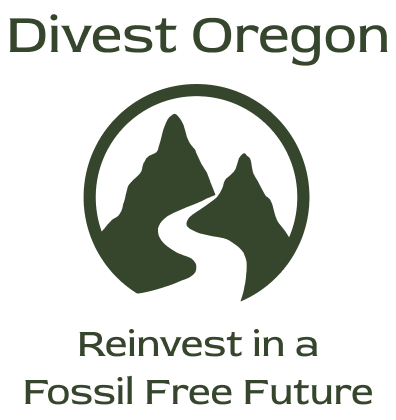Oregon Treasury's Net-Zero Plan
What's a Net-Zero Plan?
A net-zero plan is one that seeks to arrive at a balance between the amount of greenhouse gas that is produced by investments and the amount that investments remove from the atmosphere.
What Treasury fund does the Net-Zero Plan apply to?
The Oregon Treasury's Net-Zero Plan only applies to the $93 billion Oregon Public Employee Retirement Fund's - not the $40 billion that are also managed by the Treasury.
What is the Goal for the Oregon Net-Zero Plan?
The stated goal in the plan is to: “Achieve net zero portfolio emissions no later than 2050, with an interim goal of a 60% reduction in portfolio emissions intensity by 2035, relative to a 2022 baseline.”
What's in the Oregon Net-Zero Plan?
The Oregon Net-Zero Plan
Raises Significant Questions
Will the Net Zero Plan actions occur
soon enough to protect OPERF beneficiaries from climate risk?
To mitigate the financial risks of climate change, Treasury must act before the market devalues assets that are no longer wanted due to their negative climate impact. The value of investments in fossil fuels can be diminished by flooding, hurricanes, or fire caused by climate change.
Bottom line: Although the Net Zero Plan states that its 2035 60% emissions reduction and 2050 Net Zero targets are as aggressive as Treasury can be without major portfolio disruption, scientific evidence suggests major portfolio disruptions from climate change will occur sooner. The Net Zero Plan timelines should be accelerated in line with updated science to protect OPERF beneficiaries. Read more...
Is the Net Zero Plan’s measurement of investment emissions comprehensive enough to identify all of OPERF’s significant climate financial risk?
The Net Zero Plan acknowledges that analyzing the exposure of a portfolio of OPERF’s size and complexity to direct and indirect greenhouse gas emissions is essential to assess our exposure to physical and transition risks.
But the current Net Zero Plan has a significant loophole: It excludes measurement of “indirect” Scope 3 emissions, which are estimated to be 75% of a company’s emissions. For example for an oil company like Exxon, the Net Zero Plan analysis includes the company’s emissions from drilling, transporting and refining oil (Scope 1) and emissions from the power the company purchases (Scope 2), but not the majority of emissions from burning the oil or gas the company produced (Scope 3). And companies like Exxon are reporting Scope 3, yet the Net Zero Plan does not include it.
In addition, physical damage to assets due to flooding, hurricanes, or fire caused by climate change is not included in the Net Zero Plan.
Bottom Line: Omitting Scope 3 emissions and physical damage to OPERF assets due to climate change profoundly understates the risk to OPERF. Read more...

Will
engagement with fund managers
and companies to ensure OPERF investments have “credible net zero transition plans” be effective?
There is increasing evidence that engagement with fossil fuel companies does not work. The Net Zero Plan leaves key engagement criteria undefined.
Bottom Line: Given the current lack of evidence on the effectiveness of an engagement strategy, it will be up to the Treasury to demonstrate that it can satisfy its fiduciary duty to protect PERS beneficiaries by succeeding where others have consistently failed. Read more...
How will PERS beneficiaries and the public know this plan is working to protect pensions with the urgency called for by accelerating climate change?
Transparency is critical. As written, the Net Zero Plan lacks an annual robust reporting framework that would allow stakeholders to follow its implementation and ongoing results. The Plan needs to include interim targets so it can be adjusted as needed. Waiting until 2035 to know if it is “on target” is reckless. Read more...

How will the Net Zero Plan become a
formal policy
for the Oregon Investment Council (OIC)?
The Oregon Investment Council (OIC) is a 5-member board that oversees and sets policy for the Oregon Treasury. A plan to systematically mitigate climate risk is by definition a policy. The Net Zero Plan should be formalized, with the OIC ensuring that the Net Zero Plan is enacted urgently to proactively protect beneficiaries.


